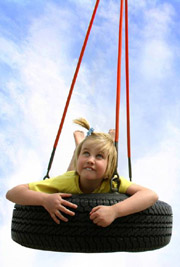What are the symptoms of ADHD?
- Are there different types of ADHD?
- At what age do the symptoms of ADHD occur?
- At what age are symptoms of ADHD the worst?
- How long do ADHD symptoms last?
- What are the DSM-IV criteria for ADHD?
- How does a health professional decide if a child has symptoms of ADHD?
What are the symptoms of ADHD?
Most kids could be described at some point as ‘inattentive’, ‘impulsive’ or ‘hyperactive’. Explanations for this behaviour vary widely, ranging from the child being ‘overtired’ to ‘overexcited’. However, when such behaviour lasts for significant periods of time and interferes with functioning at school and at home, the explanation may be due to a condition such as attention deficit hyperactivity disorder (ADHD).
ADHD is a syndrome composed of three core symptom categories: hyperactivity, inattention, and impulsivity. In order to reach an accurate diagnosis, the presence and pattern of development of symptoms in each of these categories must be considered.
Children always seem to be "on the go" or constantly in motion. Hyperactive behaviour may manifest as difficulty remaining seated when asked to do so, excessive fidgeting or talking, restlessness, or difficulty playing quietly.
Children seem unable to curb their immediate reactions or think before they act. Impulsive behaviour may be identified through disruptive behaviours in the classroom, intrusive or interrupting behaviour, poor turn taking, blurting out answers before they are appropriate, peer rejection, and accidental injury.
Children have a hard time keeping their minds on any one thing and may quickly become bored with a task. Signs that a child is inattentive include disorganisation, poor academic performance, poor concentration and attention to detail, being distracted easily, forgetfulness, losing things, and poor completion of tasks.
Are there different types of ADHD?
Not all children with ADHD have the same symptoms. Several different ‘subtypes’ of ADHD have therefore been established:
- Predominantly hyperactive-impulsive type: Does not show significant inattention.
- Predominantly inattentive type: Does not show significant hyperactive-impulsive behaviour.
- Combined type: Displays both inattentive and hyperactive-impulsive behaviour.
At what age do symptoms of ADHD occur?

Impulsive behaviour almost always occurs with hyperactivity, and develops in a similar pattern. Impulsive symptoms are usually observed by 4 years of age, increasing over the subsequent three or four years.
Inattention generally becomes apparent at 8 or 9 years of age.
At what age are symptoms of ADHD the worst?
The symptoms of hyperactivity are typically most severe at age 7 to 8, gradually declining thereafter. Peak severity of impulsive behaviour is usually at age 7 or 8. There is no specific age of peak severity for inattentive behaviour.
How long do the symptoms of ADHD last?
Hyperactive symptoms tend to resolve by adolescence. Impulsive symptoms are more likely to endure throughout adulthood. Symptoms of inattention tend to be life long.
What are the DSM-IV criteria for ADHD?
In Australia, ADHD is commonly diagnosed based on the Diagnostic and Statistical Manual of Mental Disorders, 4th edition (DSM-IV) criteria. The child must display a minimum of six out of nine symptoms of inattention, and/or a minimum of six out of nine symptoms of hyperactivity/impulsivity in order to be diagnosed with ADHD. These symptoms must:
- Have persisted for at least six months;
- Be present in two or more different settings (e.g. at school and at home);
- Be present before the age of seven years;
- Include clear evidence of clinically significant impairment in social, academic, or occupational functioning.
- Not be explained by other mental disorders (e.g. pervasive developmental disorder, schizophrenia or other psychotic disorders, mood disorder, anxiety disorder, dissociative disorder, or a personality disorder)
Inattention
Predominantly inattentive type ADHD is defined by an individual experiencing at least six of the following characteristics:
- Often fails to give close attention to details or makes careless mistakes in schoolwork, work, or other activities;
- Often has difficulty sustaining attention in tasks or play activities;
- Often does not seem to listen when spoken to directly;
- Often does not follow through on instructions and fails to finish schoolwork, chores, or duties in the workplace (not due to oppositional behaviour or failure to understand instructions);
- Often has difficulty organising tasks or activities;
- Often avoids, dislikes, or is reluctant to engage in tasks that require sustained mental effort (e.g. schoolwork or homework);
- Often loses things necessary for tasks or activities (e.g. toys, school assignments, pencils, books or tools);
- Is often easily distracted by extraneous stimuli; and/or
- Is often forgetful in daily activities.
Hyperactivity and impulsivity
Predominantly hyperactive/impulsive type ADHD is defined by an individual experiencing six of the following characteristics:
- Often fidgets with hands or squirms in seat;
- Often leaves seat in classroom or during other situations in which remaining seated is expected;
- Often runs about or climbs excessively in situations in which it is inappropriate (in adolescents or adults, may be limited to subjective feelings of restlessness);
- Often has difficulty playing or engaging in leisure activities quietly;
- Is often "on the go" or often acts as if "driven by a motor";
- Often talks excessively;
- Often blurts out answers before questions have been completed;
- Often has difficulty awaiting turn; and/or
- Often interrupts or intrudes on others (e.g. butts into conversations or games)
Combined ADHD
Combined type ADHD is defined by an individual meeting six of the attention and six of the hyperactive/impulsive characteristics.
How does a health professional decide if a child has symptoms of ADHD?
Symptoms of ADHD are usually first recognised by parents, teachers and other caregivers. The information provided to health professionals by parents has been found in studies to be very accurate in making a diagnosis of ADHD and monitoring response to treatment. Symptoms of ADHD may not be obvious within a structured clinical setting, such as a clinic visit.
ADHD is a complex condition. Diagnosis based DSM-IV criteria is therefore a good starting point; however, a formal psychological and educational assessment is more accurate and useful in identifying the diagnosis and needs of each child. Only around 3% of children diagnosed with ADHD have it in isolation. The vast majority of children with ADHD also have other conditions which need to be identified and managed. Other disorders commonly associated with ADHD include oppositional defiant disorder, conduct disorder and anxiety disorders.
More information
 |
For more information on childhood ADHD and its symptoms and treatments, as well as some useful tools and animations, see Childhood ADHD. |
 |
For more information on ADHD in adults and its treatments, as well as some useful tools and animations, see Adult ADHD. |
References
- Diagnostic and Statistical Manual of Mental Disorders (fourth edition). Washington, DC: American Psychiatric Association; 2000. [Publisher]
- Fischer M, Barkley RA, Edelbrock CS, Smallish L. The adolescent outcome of hyperactive children diagnosed by research criteria: II. Academic, attentional, and neuropsychological status. J Consult Clin Psychol. 1990;58(5):580-8. [Abstract]
- Lilienfeld SO. Scientifically unsupported and supported interventions for childhood psychopathology: A summary. Pediatrics. 2005;115(3):761-4. [Abstract | Full text]
- Mannuzza S, Klein RG. Long-term prognosis in attention-deficit/hyperactivity disorder. Child Adolesc Psychiatr Clin N Am. 2000;9(3):711-26. [Abstract]
- Mannuzza S, Klein RG, Bessler A, et al. Adult outcome of hyperactive boys. Educational achievement, occupational rank, and psychiatric status. Arch Gen Psychiatry. 1993;50(7):565-76. [Abstract]
- Merrell C, Tymms PB. Inattention, hyperactivity and impulsiveness: Their impact on academic achievement and progress. Br J Educ Psychol. 2001;71(Pt 1):43-56. [Abstract]
- Klassen A, Miller A, Raina P, et al. Attention-deficit hyperactivity disorder in children and youth: A quantitative systematic review of the efficacy of different management strategies. Can J Psychiatry. 1999;44(10):1007-16. [Abstract | Full text]
- Clinical practice guideline: Diagnosis and evaluation of the child with attention-deficit/hyperactivity disorder. Pediatrics. 2000;105(5):1158-70. [Abstract | Full text]
- Byrne JM, Bawden HN, Beattie TL, DeWolfe NA. Preschoolers classified as having attention-deficit hyperactivity disorder (ADHD): DSM-IV symptom endorsement pattern. J Child Neurol. 2000;15(8):533-8. [Abstract]
- Attention deficit and hyperkinetic disorders in children and young people: A national clinical guidline [online]. Edinburgh, UK: Scottish Intercollegiate Guidelines Network; 29 June 2001 [cited 24 December 2008]. Available from: URL link
- Carlson CL, Mann M. Sluggish cognitive tempo predicts a different pattern of impairment in the attention deficit hyperactivity disorder, predominantly inattentive type. J Clin Child Adolesc Psychol. 2002;31(1):123-9. [Abstract]
- Applegate B, Lahey BB, Hart EL, et al. Validity of the age-of-onset criterion for ADHD: A report from the DSM-IV field trials. J Am Acad Child Adolesc Psychiatry. 1997;36(9):1211-21. [Abstract]
- West J, Taylor S, Houghton S, Hudyma S. A comparison of teachers’ and parents’ knowledge and beliefs about attention-deficit/hyperactivity disorder (ADHD). School Psych Int. 2005;26(2):192-208. [Abstract]
- Faraone SV, Biederman J, Milberger S. How reliable are maternal reports of their children’s psychopathology? One year recall of psychiatric diagnoses of ADHD children. J Am Acad Child Adolesc Psychiatry. 1995;34(8):1001-8. [Abstract]
- Biederman J, Faraone SV, Monuteaux MC, Grossbard JR. How informative are parent reports of attention-deficit/hyperactivity disorder symptoms for assessing outcome in clinical trials of long-acting treatments? A pooled analysis of parents’ and teachers’ reports. Pediatrics. 2004;113(6):1667-71. [Abstract | Full text]
- Sleator EK, Ullmann RK. Can the physician diagnose hyperactivity in the office? Pediatrics. 1981;67(1):13-7. [Abstract]
- Barkley RA. ADHD and the Nature of Self-Control. New York: Guilford Press; 1997. [Publisher]
- Barkley RA. Behavioral inhibition, sustained attention, and executive functions: Constructing a unifying theory of ADHD. Psychol Bull. 1997;121(1):65-94. [Abstract]
- Houghton S, Douglas G, West J, et al. Differential patterns of executive function in children with attention-deficit/hyperactivity disorder according to gender and subtype. J Child Neurol. 1999;14(12):801-5. [Abstract]
- Attention deficit hyperactivity disorder (ADHD): NIH Publication No. 08-3572 [online]. Bethesda, MD: National Institutes of Health; 3 April 2008 [cited 24 December 2008]. Available from: URL link
- Manly T, Anderson V, Nimmo-Smith I, et al. The differential assessment of children’s attention: The Test of Everyday Attention for Children (TEA-Ch), normative sample and ADHD performance. J Child Psychol Psychiatry. 2001;42(8):1065-81. [Abstract]
- Psychprofiler [online]. Camberwell, VIC: Australian Council for Educational Research; 10 March 2008 [cited 15 January 2009]. Available from: URL link
All content and media on the HealthEngine Blog is created and published online for informational purposes only. It is not intended to be a substitute for professional medical advice and should not be relied on as health or personal advice. Always seek the guidance of your doctor or other qualified health professional with any questions you may have regarding your health or a medical condition. Never disregard the advice of a medical professional, or delay in seeking it because of something you have read on this Website. If you think you may have a medical emergency, call your doctor, go to the nearest hospital emergency department, or call the emergency services immediately.








